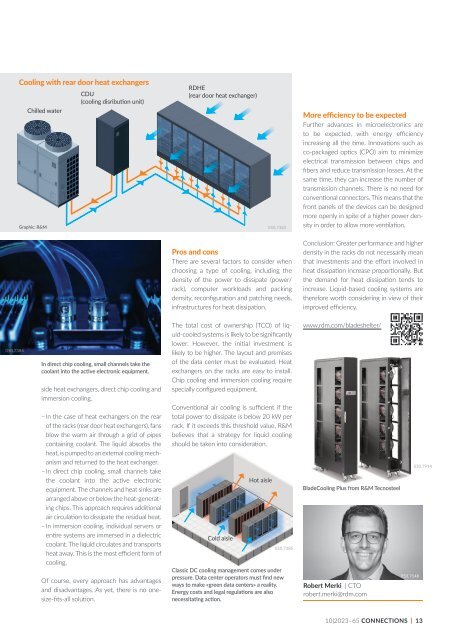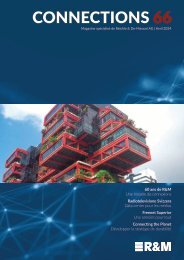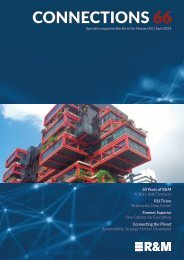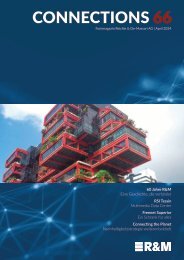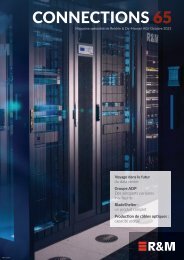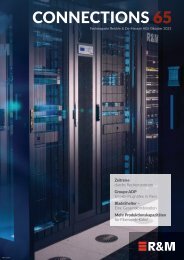CONNECTIONS_65-e
Specialist magazine CONNECTIONS no. 65
Specialist magazine CONNECTIONS no. 65
You also want an ePaper? Increase the reach of your titles
YUMPU automatically turns print PDFs into web optimized ePapers that Google loves.
Cooling with rear door heat exchangers<br />
Chilled water<br />
Graphic: R&M<br />
CDU<br />
(cooling disribution unit)<br />
RDHE<br />
(rear door heat exchanger)<br />
050.7382<br />
More efficiency to be expected<br />
Further advances in microelectronics are<br />
to be expected, with energy efficiency<br />
increasing all the time. Innovations such as<br />
co-packaged optics (CPO) aim to minimize<br />
electrical transmission between chips and<br />
fibers and reduce transmission losses. At the<br />
same time, they can increase the number of<br />
transmission channels. There is no need for<br />
conventional connectors. This means that the<br />
front panels of the devices can be designed<br />
more openly in spite of a higher power density<br />
in order to allow more ventilation.<br />
Pros and cons<br />
There are several factors to consider when<br />
choosing a type of cooling, including the<br />
density of the power to dissipate (power/<br />
rack), computer workloads and packing<br />
density, reconfiguration and patching needs,<br />
infrastructures for heat dissipation.<br />
Conclusion: Greater performance and higher<br />
density in the racks do not necessarily mean<br />
that investments and the effort involved in<br />
heat dissipation increase proportionally. But<br />
the demand for heat dissipation tends to<br />
increase. Liquid-based cooling systems are<br />
therefore worth considering in view of their<br />
improved efficiency.<br />
050.7384<br />
In direct chip cooling, small channels take the<br />
coolant into the active electronic equipment.<br />
side heat exchangers, direct chip cooling and<br />
immersion cooling.<br />
– In the case of heat exchangers on the rear<br />
of the racks (rear door heat exchangers), fans<br />
blow the warm air through a grid of pipes<br />
containing coolant. The liquid absorbs the<br />
heat, is pumped to an external cooling mechanism<br />
and returned to the heat exchanger.<br />
– In direct chip cooling, small channels take<br />
the coolant into the active electronic<br />
equipment. The channels and heat sinks are<br />
arranged above or below the heat-generating<br />
chips. This approach requires additional<br />
air circulation to dissipate the residual heat.<br />
– In immersion cooling, individual servers or<br />
entire systems are immersed in a dielectric<br />
coolant. The liquid circulates and transports<br />
heat away. This is the most efficient form of<br />
cooling.<br />
Of course, every approach has advantages<br />
and disadvantages. As yet, there is no onesize-fits-all<br />
solution.<br />
The total cost of ownership (TCO) of liquid-cooled<br />
systems is likely to be significantly<br />
lower. However, the initial investment is<br />
likely to be higher. The layout and premises<br />
of the data center must be evaluated. Heat<br />
exchangers on the racks are easy to install.<br />
Chip cooling and immersion cooling require<br />
specially configured equipment.<br />
Conventional air cooling is sufficient if the<br />
total power to dissipate is below 20 kW per<br />
rack. If it exceeds this threshold value, R&M<br />
believes that a strategy for liquid cooling<br />
should be taken into consideration.<br />
Cold aisle<br />
Hot aisle<br />
050.7385<br />
Classic DC cooling management comes under<br />
pressure. Data center operators must find new<br />
ways to make «green data centers» a reality.<br />
Energy costs and legal regulations are also<br />
necessitating action.<br />
www.rdm.com/bladeshelter/<br />
BladeCooling Plus from R&M Tecnosteel<br />
Robert Merki | CTO<br />
robert.merki@rdm.com<br />
050.7148<br />
030.7914<br />
10|2023–<strong>65</strong> <strong>CONNECTIONS</strong> | 13


